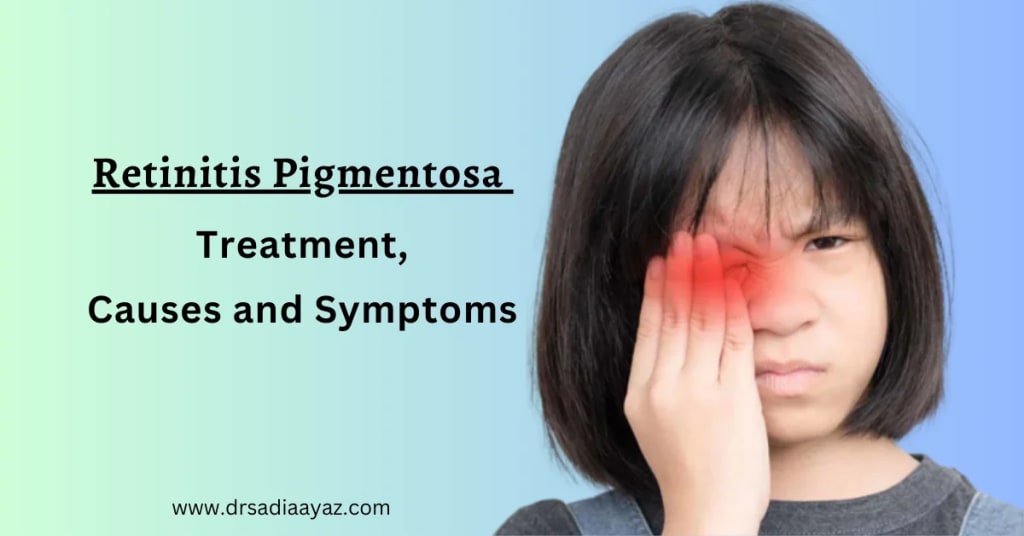The Latest Breakthroughs in Retinitis Pigmentosa Treatment 2022
Retinitis Pigmentosa Treatment

What is Retinitis Pigmentosa?
Retinitis pigmentosa is a genetic disorder that affects the photoreceptors layer of the retina specifically the rod photoreceptors and later on the involvement of the cones and causing its degeneration. It causes a gradual reduction in vision and eventually leads to blindness. It is also considered the most common hereditary fundus dystrophy. There is no permanent retinitis pigmentosa treatment however research is made to alleviate the symptoms and improve the lifestyle of the patients. The retinitis pigmentosa treatment is one of the challenges for recent science because the lost photoreceptors cannot be regenerated. The article will discuss inheritance patterns, causes, signs and symptoms, ocular complications, and syndromes associated with retinitis pigmentosa treatment options.
Retinitis Pigmentosa ICD 10
What is the ICD 10 code for retinitis pigmentosa?
It is the international coding used for different diseases. The ICD 10 code for retinitis pigmentosa is H35.52. It is important for documentation purposes of this disease.
What is retinitis pigmentosa
INHERITANCE PATTERN
What is the inheritance pattern of retinitis pigmentosa?
Retinitis pigmentosa can occur as a sporadic condition however autosomal dominance, autosomal recessive, and X-linked recessive inheritance patterns are also labeled. The sporadic cases occurring without a previous genetical history have a very favorable outcome. Autosomal dominant inheritance has the best prognosis. However, X-linked recessive inheritance, which is the least common inheritance pattern, has the worst prognosis. It is also believed that certain drugs may also be associated with causing retinitis pigmentosa, examples include quinine and phenothiazine.
CAUSES, SIGNS, AND SYMPTOMS
Retinitis Pigmentosa Causes
What are the causes of retinitis pigmentosa?
One of the most commonly established causes of retinitis pigmentosa includes the allelic variation or mutation of the rhodopsin gene that leads to the expression of the mutagenic gene and the phenotype of the disease.
Retinitis Pigmentosa Symptoms
What are the symptoms of retinitis pigmentosa?
Nyctalopia: The most common symptom of retinitis pigmentosa is nyctalopia or night blindness. It is the first symptom observed by the patient. Other associated symptoms include
Reduced peripheral vision and central vision may also be involved but in later stages. The reduced vision is usually labeled as “tunnel vision” to signify the peripheral visual field defect.
Photopsia
Reduced color vision
Retinitis pigmentosa signs
What are the signs of retinitis pigmentosa?
The signs of retinitis pigmentosa include
Contrast sensitivity: Visual acuity in retinitis pigmentosa may be normal however contrast sensitivity will be markedly reduced in the initial stages.
Bone spicules retinal pigmentation: Bilateral and peripheral perivascular pigmentation may signify bone spicules.
Disc pallor: The disc in RP appears as waxy in color labeled as “waxy disc pallor”
Tessellated fundus: There is a gradual increase in pigmentation in the peripheral retina encroaching centrally. The unmasking of the choroidal vessels gives the tessellated fundus appearance.
Arteriolar attenuation:
Myopia: It is a common complaint in retinitis pigmentosa patients
ERM: Epiretinal membrane formation is common in retinitis pigmentosa
Cystoid macular edema
Disc drusen occur more frequently in RP patients.
OCULAR COMPLICATIONS OF RETINITIS PIGMENTOSA
What are the ocular complications of retinitis pigmentosa?
Common ocular complications of retinitis pigmentosa include
Posterior subcapsular cataract (most common)
Open-angle glaucoma
Keratoconus
Intermediate uveitis
Posterior vitreous detachment
Exudative retinal detachment
SYNDROMES ASSOCIATED WITH RETINITIS PIGMENTOSA
What are the different types of syndromes associated with retinitis pigmentosa?
ATYPICAL RETINITIS PIGMINTOSA
The term atypical retinitis pigmentosa is used to combine a group of diseases having features common with typical retinitis pigmentosa. These include
Syndromic RP or atypical RP associated with systemic diseases
Usher syndrome: It is an autosomal recessive disorder. The most common feature is deafness in children. Half of the cases have combined blindness and deafness.
Kearns Sayre syndrome: It has a mitochondrial inheritance pattern and is characterized by CPEO (chronic progressive external ophthalmoplegia) with ptosis and cardiac problems. The fundus shows a typical appearance of salt and pepper retinopathy.
Bassen Kornzweig syndrome: It is also known as abetalipoproteinemia. It is an autosomal recessive disorder. The disease is associated with dysfunction of fat- and fat-soluble vitamins D, E, A, and K. In children, there is failure to thrive and associated spinocerebellar ataxia.
Refsum disease: It is an autosomal recessive disorder. It is a genetic condition associated with abnormal accumulation of phytanic acid accumulation in different regions of the body. It manifests as changes in skin such as skin thickening and other neurological and visceral changes. The fundus gives a salt and pepper appearance.
Bardet Biedl syndrome: It is a genetically heterogenous entity and is associated with polydactyly, mental handicap and bulls-eye maculopathy.
DIAGNOSIS AND TESTS
How is retinitis pigmentosa diagnosis made?
The diagnosis of retinitis pigmentosa includes detailed ophthalmic examination by an ophthalmologist, followed by a series of investigations as followed
Visual equity: Most of the patients have normal visual acuity in the initial stages however in advanced cases marked reduction in visual acuity will be observed.
Contrast sensitivity: It is markedly decreased even in the initial stages of the disease.
Perimetry: Initially perimetry signifies mid-peripheral changes in the visual field.
Dark adaptation: It is prolonged in retinitis pigmentosa
Full Field Electroretinography: It is one of the most sensitive tests for RP. It shows reduces scotopic rod and combined responses. The photopic response is reduced with the progression of the disease and in advanced cases ERG diminishes.
Electrooculography: It is subnormal in RP
Optical coherence tomography: OCT is used to identify the complications such as cystoid macular edema and epiretinal membrane formation.
Genetic testing for Retinitis Pigmentosa: Genetical testing is a procedure to recognize the diseased gene in a particular person. It is useful in persons with a family history of retinitis pigmentosa. It helps in early recognition of the disease and to control the disease progression. It is also important in stopping the further transfer of the gene in the children by avoiding family marriages.
MANAGEMENT AND TREATMENT
Retinitis Pigmentosa Treatment
Current Treatment Options for Retinitis Pigmentosa
There is no retinitis pigmentosa treatment for permanent eradication of the disease, however, some medications and steps can be taken to control the progression and improve the lifestyle of the affected person and to avoid genetic transfer of the disease.
Regular follow-up: Regular check by ophthalmologist is crucial in the early detection of vision-treating diseases and their time management.
Gene therapy for retinitis pigmentosa:
Gene therapy is a recent advancement in dealing with retinitis pigmentosa.for more details click here
About the Creator
sadia ayaz
My name is Dr. Sadia Ayaz and I am an ophthalmologist and eye surgeon. My medical degree is from Pakistan, I have done FCPS-1 / IMM from the College of Physicians and Surgeons Pakistan.





Comments
There are no comments for this story
Be the first to respond and start the conversation.